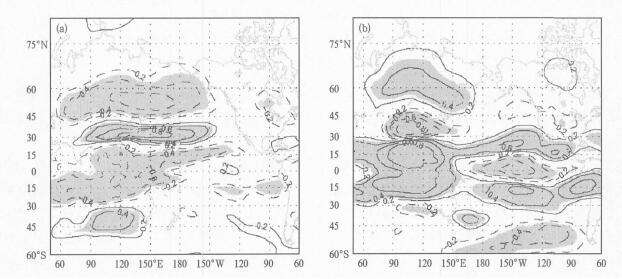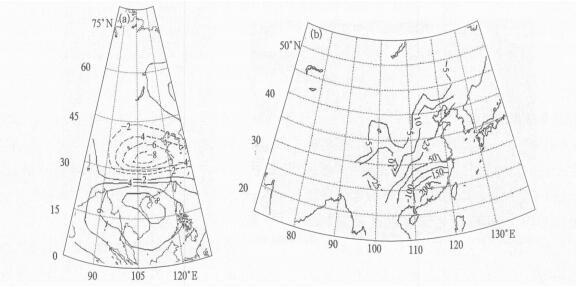冬季东亚中纬度西风急流对我国气候的影响
Influences of the East Asian Jet Stream on Winter Climate in China
-
摘要: 利用1957—2001年欧洲中期数值天气预报中心再分析资料及地面台站观测资料,分析了冬季东亚西风急流与我国气候的关系。首先定义了冬季东亚西风急流强度指数(区域30°~35°N,127.5°~155°E冬季200 hPa纬向风u200平均值的标准化值)和切变指数(区域15°~25°N,100°~115°E与区域30°~40°N,100°~115°E的平均u200之差的标准化值),这两个指数能较好地反映冬季东亚西风急流的强度变化和位置的南北移动,二者相关系数为-0.48,通过99%信度检验。西风急流强度与亚洲和西太平洋大范围的大气环流有密切关系,而西风急流位置移动则与印度洋、中东太平洋的大气环流有密切关系,并分析了冬季急流强度指数和切变指数与我国温度和降水的关系。结果表明:当西风急流强度偏强时,西风急流位置偏北,此时在急流入口区左侧由于气流辐合造成低层气压上升,在出口区左侧则由于气流发生强烈辐散,引起低层气压下降,所以西伯利亚地区上空从对流层低层到中层高度值升高,北太平洋高度值降低,东西向气压差加大的形势,同时东亚大槽偏强,海陆气压差加大和东亚大槽偏强,导致冬季风强度偏强,引起我国从北到南的陆面降温,同时30°~40°N低层有下沉气流,使得华北、华中和长江中下游地区降水偏少;当西风急流强度偏弱时,西风急流位置偏南,整个东亚地区存在南风异常,东亚冬季风较弱,在25°N附近有上升气流,此时华南和内蒙古、华北降水偏多,内蒙古地表温度偏高。Abstract: The European Center for Medium Range Weather Forecasts reanalysis data sets and the observed data for precipitations and temperatures in China are used to depict the relationships between the eastern China climate and the East Asian jet stream (EAJS). With an emphasis on the northern winter seasons and on the interannual timescales, the variations of the intensity and the meridional displacement of EAJS and their relationships with the precipitations and temperatures are analyzed, and the relative connections of the EAJS and the winter monsoon to the anomalies of atmospheric circulation in the eastern China region are assessed. The intensity index(normalized mean u200 averaged over 30°—35°N, 127.5°—155°E)and the shear index of EAJS (normalized u200 difference between two areas over 15°—25°N, 100°—115°E and 30°—40°N, 100°—115°E) are first defined, which can reasonably reflect the interannual variation of the intensity and meridional displacement of EAJS, then relative connections of intensity index and shear index with winter temperatures and precipitations in China for period 1957—2001 are investigated respectively. The correlation coefficient between the intensity index and the shear index is -0.48 (exceeding 99% confidence limit), which means that when EAJS intensifies the meridional displacement of EAJS is abnormally southward. It is found that the intensity of EAJS is associated with the extensive atmospheric circulation in Asia and west Pacific, while the meridional displacement of EAJS does strongly link to the atmospheric circulation in the tropical central eastern Pacific and the Indian Ocean. The possible way of winter EAJS affecting the precipitation and temperature of China can be described as follows: At the left side of the entrance region of EAJS the pressure of low level atmosphere increases due to the convergent flows, meanwhile at the left side of exit region of EAJS the pressure of low level atmosphere decreases because of the divergent flows. So in the mid lower level of the troposphere the pressure over Mongolia and Siberia increases and that over the north Pacific decreases, which results in both the difference between them increasing and the East Asian trough deepening. The increased difference of geopotential height between land and sea and the intensified East Asian trough may make winter monsoon intensify, resulting in the drop of temperature in the east part of China, meanwhile there are descending flows over the 30°—40°N that make the precipitation decrease over the northern China, the middle China and the mid lower reaches of the Yangtze River. When EAJS weakens abnormally and the displacement of EAJS is abnormally southward, the south wind occurs in the whole East Asia indicating the weak winter monsoon, while there are ascending flows over the east part of 25°N. At that time the precipitation in the southern China, Inner Mongolia and the northern China increases, and the temperature of Inner Mongolia is high abnormally.
-
Key words:
- East Asian jet stream;
- intensity index;
- shear index;
- winter climate
-
图 7 冬季强弱指数年850 hPa风场合成差值(矢量)和1000 hPa高度场差值(强年减弱年; 等值线, 单位: m)合成图(a)强度指数(图中最大风矢为8.91 m/s),(b)切变指数(图中最大风矢为8.98 m/s)
Fig. 7 Composites of winter wind anomaly(vectors)at 850 hPa level and 1000 hPa height anomaly(contour lines, unit:m)(a)the intensity index,(b)the shear index(the maximums of velocity are 8.91 m/s in(a)and 8.98 m/s in(b))
表 1 冬季风与东亚急流强度指数、切变指数的相关系数及偏相关系数
Table 1 The correlation coefficient and partial correlation coefficient between winter monsoon and intensity index and shear index

-
[1] Krishnamurti T N.The subtropical jet stream of winter.J Meteor, 1961, 18:172-191. doi: 10.1175/1520-0469(1961)018<0172:TSJSOW>2.0.CO;2 [2] Hou A Y.Hadley circulation as a modulator of the extratropical climate.J Atmos Sci, 1998, 55:2437-2457. doi: 10.1175/1520-0469(1998)055<2437:HCAAMO>2.0.CO;2 [3] Kung E C, Chan P H.Energetics characteristics of the Asian winter monsoon in the source region.Mon Wea Rev, 1981, 109:854-870. doi: 10.1175/1520-0493(1981)109<0854:ECOTAW>2.0.CO;2 [4] Yang S, Lau K M, Kim K M.Variations of the East Asian jet stream and Asian-Pacific-American winter climate anomalies.J Climate, 2002, 15:306-324. doi: 10.1175/1520-0442(2002)015<0306:VOTEAJ>2.0.CO;2 [5] Lin Z D, Lu R Y.Interannual meridional displacement of the East Asian upper-tropospheric jet stream in summer.Adv Atmos Sci, 2005, 22:199-211. doi: 10.1007/BF02918509 [6] Liang X Z, Wang W C.Association between China monsoon rainfall and tropospheric jets.Quart J Roy Meteor, 1998, 124:2597-2623. doi: 10.1002/(ISSN)1477-870X [7] 史玉光, 杨舵, 陈洪武.北半球冬季副热带西风急流及有关环流季内振荡若干特征分析.新疆气象, 1999, 22(2):1-6. http://www.cnki.com.cn/Article/CJFDTOTAL-XJQX199902000.htm [8] Chang C P, Lau K M.Northeasterly cold surges and near-equatorial disturbances over the winter MONEX area during December 1974.PartⅡ:Planetary-scale aspects.Mon Wea Rev, 1982, 108:298-312. https://www.researchgate.net/publication/252229380_Northeasterly_Cold_Surges_and_Near-Equatorial_Disturbances_over_the_Winter_MONEX_Area_During_December_1974_Part_II_Planetary-Scale_Aspects [9] 张元箴, 吴洪, 张兴旺.北半球冬季冷涌及其反馈过程对我国南方降水的影响.应用气象学报, 1993, 4(4):481-486. http://qikan.camscma.cn/jams/ch/reader/view_abstract.aspx?file_no=19930481&flag=1 [10] Compo G P, Kiladis G N, Webster P J.The horizontal and vertical structure of east Asia winter monsoon pressure surges.Quart J Meteor Soc, 1999, 125:29-54. doi: 10.1002/(ISSN)1477-870X [11] Lau K M, Chang C P, Chan P H.Short-term planetary-scale interactions over the tropics and midlatitudes.PartⅡ:Winter-MONEX period.Mon Wea Rev, 1983, 111:1372-1388. doi: 10.1175/1520-0493(1983)111<1372:STPSIO>2.0.CO;2 [12] Lau K M, Boyle J S.Tropical and extratropical forcing of the large-scale circulation:A diagnostic study.Mon Wea Rev, 1987, 115:400-428. doi: 10.1175/1520-0493(1987)115<0400:TAEFOT>2.0.CO;2 [13] 李崇银, 王作台, 林士哲, 等.东亚夏季风活动与东亚高空西风急流位置北跳关系的研究.大气科学, 2004, 28(5):641-658. http://www.cnki.com.cn/Article/CJFDTOTAL-DQXK200405000.htm [14] Silva A M D, Lindzen R S.On the establishment of stationary waves in the northern hemisphere winter.J Atmos Sci, 1993, 50:43-61. doi: 10.1175/1520-0469(1993)050<0043:OTEOSW>2.0.CO;2 [15] Jhun J G, Lee E J.A new East Asian winter monsoon index and associated characteristics of the winter monsoon.J Climate, 2004, 17(4):711-726. doi: 10.1175/1520-0442(2004)017<0711:ANEAWM>2.0.CO;2 [16] 杨素英, 王谦谦, 孙凤华.中国东北南部冬季气温异常及其大气环流特征变化.应用气象学报, 2005, 16(3):334-344. http://qikan.camscma.cn/jams/ch/reader/view_abstract.aspx?file_no=20050342&flag=1 [17] 廖清海, 高守亭, 王会军, 等.北半球夏季副热带西风急流变异及其对东亚夏季风气候异常的影响.地球物理学报, 2004, 47(1):10-18. http://www.cnki.com.cn/Article/CJFDTOTAL-DQWX200401002.htm [18] 郭其蕴.东亚冬季风的变化与中国气温异常的关系.应用气象学报, 1994, 5(2):218-225. http://qikan.camscma.cn/jams/ch/reader/view_abstract.aspx?file_no=19940238&flag=1 [19] Gong D Y, Ho C H.The Siberian high and climate change over middle to high latitude Asia.Theor Appl Climatol, 2002, 72:1-9. doi: 10.1007%2Fs007040200008 [20] Gong D Y, Wang S W, Zhu J H.East Asian winter monsoon and Arctic Oscillation.Geophys Res Lett, 2001, 28(10):2073-2076. doi: 10.1029/2000GL012311 [21] Lau K M, Kim K M, Yang S.Dynamical and boundary forcing characteristics of regional components of the Asian summer monsoon.J Climate, 2000, 13:2461-2482. doi: 10.1175/1520-0442(2000)013<2461:DABFCO>2.0.CO;2 [22] Lu R Y.Associations among the components of the east Asian summer monsoon streams in the meridional direction.J Meteor Soc Japan, 2004, 82:155-165. doi: 10.2151/jmsj.82.155 [23] Blackmon M L, Wallace J M, Lau N C, et al.An observational study of the Northern Hemisphere wintertime circulation.J Atmos Sci, 1977, 34:1040-1053. doi: 10.1175/1520-0469(1977)034<1040:AOSOTN>2.0.CO;2 [24] 丁一汇. 高空急流及其有关的次级环流∥高等天气学(第二版). 北京: 气象出版社, 2005: 138-150. [25] Cressman G P.Circulation of the West Pacific jet stream.Mon Wea Rev, 1981, 109:2450-2463. doi: 10.1175/1520-0493(1981)109<2450:COTWPJ>2.0.CO;2 [26] 施能, 朱乾根.1873-1995年东亚冬、夏季风强度指数.气象科技, 2003,(3):14-18. http://www.cnki.com.cn/Article/CJFDTOTAL-QXKJ200003002.htm [27] 王会军, 姜大膀.一个新的东亚冬季风强度指数及其强弱变化之大气环流场差异.第四纪研究, 2004, 24(1):19-27. http://www.cnki.com.cn/Article/CJFDTOTAL-DSJJ200401002.htm [28] Chen W, Graf H F, Huang R H.The interannual variability of east Asian winter monsoon and its relation to the summer monsoon.Adv Atmos Sci, 2000, 17(1):48-60. doi: 10.1007/s00376-000-0042-5 [29] 晏红明, 段玮, 肖子牛.东亚冬季风与中国夏季气候变化.热带气象学报, 2003, 19(4):367-376. http://www.cnki.com.cn/Article/CJFDTOTAL-RDQX200304003.htm [30] 孙柏民, 李崇银.冬季东亚大槽的扰动与热带对流活动的关系.科学通报, 1997, 42(5):500-504. http://www.cnki.com.cn/Article/CJFDTOTAL-KXTB199705014.htm [31] Lau N C, Nath M J.A general circulation model study of the atmospheric response to extratropical SST anomalies observed in 1950-79.J Climate, 1990, 3:965-989. doi: 10.1175/1520-0442(1990)003<0965:AGCMSO>2.0.CO;2 -


 设为首页
设为首页 加入收藏
加入收藏



 下载:
下载:






